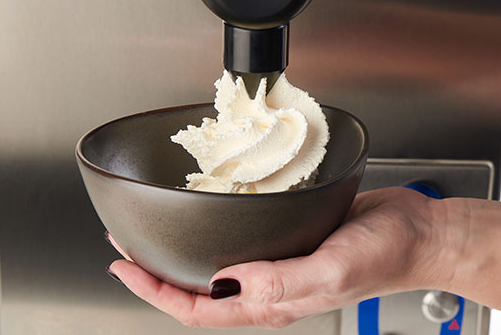Perfect Cream – Our Passion
Cream is a miracle of nature. It is a cure for stress and bad mood. It causes a sense of well-being and relaxation. Because cream is fluffy and sweet, light and tasty, pure and healthy. It dissolves on the tongue, creates a warm sense of well-being and – through its whiteness and gentle rounded shape – also has a sensual visual appearance. A dollop on your breakfast coffee, the finishing touch for tomato soup at lunchtime, a delicate accompaniment to pastry for afternoon tea, on ice cream, or to add body to the after-dinner Irish coffee: no day is complete without cream.

To spread happiness is the purpose of our existence, and one of the very highest pleasures is the indulgence in good food. True pleasure is the result of culinary perfection. In short: cream is the key to happiness. It is no coincidence that cream unites the noblest that nature can offer, i.e. the part that collects on the surface of the milk, with the accomplishment of centuries of development – the crème de la crème of the art of catering and culinary perfection.
It is this perfection to which we at SANOMAT have dedicated our lives. Each of our developments is a homage to fresh, tasty whipped cream. Every day, we are in pursuit of perfect form, ideal volume and perfect flavour and consistency. Our findings are implemented in our machines to make them easy to use and energy-efficient, ensure foolproof hygiene and optimum cooling performance to help our customers get the best out of cream.
We work for the professionals
The decorative cream topping: one of the apparently easy as pie exercises for confectioners and pastry chefs. Often, it works fine – but not always. Whipped by hand, the cream may remain too runny or may almost turn to butter. Neither is acceptable for the professional chef, who must provide perfect results every day, creating meals that taste home-made and yet must have that special something. Stability, perfect volume and flavour are the characteristics of cream that customers can judge and appreciate.
In addition, consumers’ expectations regarding health (organic food), production (regional), fair trade and sustainability have been steadily rising for a long time. Quality is a key issue.
For real, fresh whipping cream, high quality means quality ingredients, careful processing and good taste. To achieve this, SANOMAT has been producing cream whipping machines since 1954 that get the best out of cream. The more air gets into the cream during whipping, the higher the resulting volume. This means that the same amount of liquid cream can yield different amounts of whipped cream. Vaihinger SANOMAT has the right machine for every application. In bakeries, large amounts of whipped cream are required all at once. That calls for a device without its own cooling system but with a particularly efficient motor. In ice cream parlours, whipped cream must be on tap all the time: well cooled, immediately available and precisely dosed.
At SANOMAT we are familiar with our customers’ trades. With our network of regional managers, we are available on site throughout Germany and know what is important to the user.
SANOMAT cream etiquette
What is cream?
Cream is one of the most valuable dairy products. Cream contains concentrated milk fat and fat-soluble vitamins – such as vitamins A, D, E and beta-carotene in the form of provitamin A – as well as flavourings bound to the fat. Every day, consumers enjoy whipped cream. Chefs use sour cream or crème fraîche to refine their dishes.
How is whipped cream produced?
Cream is the fatty portion of milk that collects on the surface when milk is left to stand. It is either scooped off or – more commonly today – extracted through centrifugation. In both cases separation takes place due to the lower density of the milk fat compared to the remaining low-fat milk.
Fresh cream can be kept in the refrigerator for four to six days; ultra heat treated cream keeps for up to six weeks at room temperature and sterilised cream for up to one year. The heat treatment changes the flavour of the cream.
How does whipped cream become stiff?
When cream is whipped, air is mixed into it. The fat globules in the cream have protein molecules on their surface that adhere to the whipped-in air bubbles. This results in an increasingly fine three-dimensional, firm mesh in which the air is trapped. The volume of whipped cream is about twice that of unwhipped cream. If the cream is whipped for too long or too vigorously, the fat particles clump together to form butter.
What is the best way to store cream?
Either in a refrigerator in its original container or in a separate sealable container at about 5 to 7°C, or in the switched-on whipping machine. In the latter case you should, of course, make sure that the content is fully used up within two days and the machine is cleaned and disinfected every day.
Is cream subject to quality variations?
A feed change in spring and autumn or the cattle’s move from pasture to stable or vice versa can result in a change of whipping behaviour even in the same brand of cream, since the amount of fat in the cream can change through the cattle’s change in feed.
Freezing cream and thawing it again can also result in a loss of quality, making it more difficult to whip the cream.
To obtain optimum whipping quality, the cream should have a temperature of 5 to 7°C.
Can I also use a SANOMAT to beat egg white?
The SANOMAT is perfectly suited to quickly produce fluffy beaten egg white. With only a small adjustment, your machine is ready for this purpose. Especially pastry chefs benefit from the ability to produce high-quality, stable beaten egg white.
